choreography & writing | Twitter: @AshwellCharlie | email: [email protected]
Don't wanna be here? Send us removal request.
Text
F U T U R E R I T U A L response
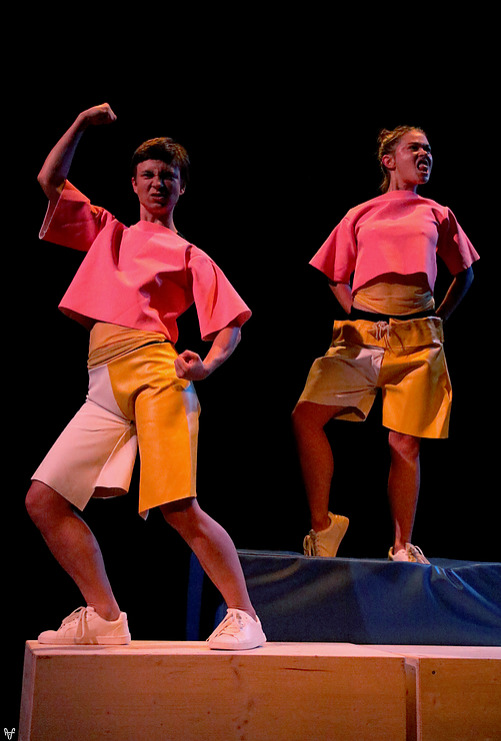
A commissioned response to F U T U R E R I T U A L (Arnolfini, Bristol, October 2018). Photo by Asher Fynn, of DAS GLAMOUR.
I cannot take the future, or ritual, for granted. A future ritual is something we do together and I definitely don’t agree with all of you. How to be together, then? How to remember what we came for?
In order to watch, to be there, receiving, thinking with, thinking about, F U T U R E R I T U A L - a series of performances, a series of series, a plural in the singular, a singular plurality, a thread, a plait - I’ll agree to disagree; to struggle, to writhe, to wiggle with my eyes and words, to embrace partiality, to allow the risk of cliché, the cliché of risk, to bounce off my burning body and onto yours.
The body burns because it’s embarrassing to watch performance, to perform audiencehood, to acquiesce to encounters you never sought out or imagined; to allow intimacy into square feet you would rather keep for yourself; a fragile, unsafe self. The mutual suspension of comfort for something else is perhaps the most precious ritual of all, though, so for now I agree to be thrown sideways into other people. Into other people’s futures. Into other people’s rituals. Let’s begin, I think. I stop thinking.
Kitty Fedorec has a suitcase of cassette tapes. She’s gothed-up, wig flying in our faces, daring us to diss or squirm or admire too lovingly, revealing our own fandoms, our own dominions. I lean forward. There are atlases on the floor. She stands on them. A string of dances, steady and studied.
She dances in defiance of something and I wonder whether every dance ever is in defiance of something. I think about my recent desire for only dances, no dancers. She speaks about mental health and feeling under constant threat. She speaks about the nation state being unwell. “The nation state wishes it was an eagle.”
She conducts a participatory war game with two audience members and I think about individual identity within and against national identity; the requirement to participate in nationhood, to “be a good sport”. I feel caught out; I’ve said ‘yes’ to this; to party politics; to paying taxes; to pressing send; to submission. Perhaps we can’t make art without making conversation with the parasites; the war machines. We’re already good sports for turning up, turning out, turning our love for possibility into social capital. To turn away is to taint the possibility of togetherness actually being pleasurable at some point in the future. I wonder whether the nation is always doomed to make war, whether the individual is always doomed to be a national treasure, whether outbreaks of violence are always synonymous with war and what would it be to violently break the state, our collective state of loneliness; the individual, the art institution, the dancer, the family, the monarchy, the dutiful subject, the artwork-as-commodity, the infinite misunderstandings of each other, into a billion shards? I wonder about this country. I wonder how to get rid of the billionaires. I wonder about sunken ships. And sunken desires for escape. How to raise them from the bottom of the sea?
I can’t remember how she ended up naked, but I do remember her singing with her band, which suddenly arose from the corner of the room, like solid ghosts. Gold leaf falls off her face. She’s only wearing a biker jacket, and a pair of Ray-Bans. I want to hang off her. Every word.
Joseph Morgan Schofield acts with and upon their body, calmly not-so-calmly piercing skin as if it was fabric. Not-so-calm because it requires me to be there, the witness, diluted in my witnessing, distracted, wanting rather to drape myself over the person next to me and breathe only in for a while, as Joseph takes care of breathing out. Or is it the other way around? Joseph does the breathing in, we do the breathing out. The tip of my tongue presses lightly into my front teeth and I suck the sides of this stupid, mute, always-active organ inwards, creating a rush of cold air between top and bottom jaw. “Thssshhhhhh.” Would I bite the bullet? Would I grab the needle? Would I feel pleasure? I feel only their body matters. I feel heroic for not running up and saving them and then I feel stupid and then I feel sad and then I feel brave and then I feel hot. We’ve all agreed to watch and learn. We consent to every moment because they’ve consented to the longest moment and all the moments and all the labour before and afterwards. The cleaning, the white flannel that turns red, the tentative, too-casual post-show discussions, the avoidances, the calm after the storm, the storm swirling above and around us as they tip hot wax onto their arm.
There’s a tension between action and impact, reaction and smooth, calm observation. Body as observant subservience. Malleable bloodstream. Tightening skin. Decisions made long ago coming back to serve us an enormous platter of fuck-the-present, hold-on-tight, simply-close-your-eyes-if-you-need-to feeling.
I’m starting to really want a tattoo.
DAS GLAMOUR are two but actually three people. I’m reminded of a Twitter meme about an imagined future with no men. Funny how fast a group of three becomes societal in scale. Perhaps I’ve re-internalised the compulsion to reproduce that haunted me for a while between 2014 and 2017. I can see them reproducing like spider plants - asexually - which isn’t to say they don’t have sex, but that sex is at last discontinuous with making babies - before and beyond my eyes and into a future beyond patriarchy, a world and word that feels so vintage already. Perhaps I’m getting ahead of myself. Perhaps you’re not ready to sign up to this spider future. In any case, I’m not entirely sure how we get from here to there without killing anyone - cookshops of the future, etc - so for now I’ll scale it down and focus on these three; this time.
It was 2018. It was autumn. I was wearing black. I was squatting, open-mouthed, with a group of other open mouths in a recently-defunded arts space to watch silently one of the most unapologetically constructivist, bish bash bosh, open-heartedly curious, in-love utopic, choreographic body-voice-drum-song works I’ve ever squatted open-mouthed in front of.
They yodelled. They stood on boxes. They stamped. Their voices were clear and calm and technical and guttural without the machismo of musicians and definitely none of the desperate, aspirational subjecthood of dancers. They just sang because singing is an animal faculty. They moved because moving is in them. Because singing and moving and drumming are pure vibration. Pure desire.
Are they the vision of a future with only dances, no dancers? Who is the artist here? Who is the muse? Who has been taught? Who did the teaching? Who downloaded the holy text and from where? Who is this serving if not everybody? Who are they if not the ghosts of a future ritual without the need for fixed meanings or labour-as-we-know-it or nations or property or anxiety, except the continuous consideration of which pleasure we’ll take next?
Is there violence in dragging ritual from its deep history and chucking it into the future? Or chucking the future upon it? Maybe. But then I’m not much of a pacifist. I like things that smash together. I like shards. I like to read futures from fragments. We’re all witches here, DAS GLAMOUR seem to say, and don’t care for our agreement or disagreement. Just that we’re here. And it’s not that special. Perhaps performance isn’t that special, just unusual.
How many times have you slipped through time into a dark room to watch silently the glitter, the reddening skin, the guitar strings, the erotic implications, the lighting rig, the other nervous witches? Let’s assume there is the potential to agree on a future. Or many intersecting futures, at least. You cannot produce your future separately from mine, or theirs, so don’t even try.
DAS GLAMOUR sing, and their song stays with me:
“desire, desire, desire, desire, desire, desire, desire, desire, desire, desire, desire, desire, desire, desire, desire, desire, desire, desire, desire, desire, desire, desire, desire, desire, desire, desire, desire, desire, desire, desire, desire, desire, desire, desire, desire, desire, desire, desire, desire, desire, desire, desire, desire, desire, desire, desire, desire, desire, desire, desire, desire, desire, desire, desire, desire, desire, desire, desire, desire, desire, desire, desire, desire, desire, desire, desire, desire, desire, desire, desire, desire, desire, desire, desire, desire, desire, desire, desire, desire, desire, desire, desire, desire, desire, desire, desire, desire, desire, desire, desire, desire, desire, desire, desire, desire, desire, desire, desire, desire, desire, desire, desire, desire, desire, desire, desire, desire, desire, desire, desire, desire, desire, desire, desire, desire, desire, desire, desire, desire, desire, desire, desire, desire, desire, desire, desire, desire, desire, desire, desire, desire, desire, desire, desire, desire, desire, desire, desire, desire, desire, desire, desire, desire, desire, desire, desire, desire, desire, desire, desire, desire, desire, desire, desire, desire, desire, desire, desire, desire, desire, desire, desire, desire, desire, desire, desire, desire, desire, desire, desire, desire, desire, desire, desire, desire, desire, desire, desire, desire, desire, desire, desire, desire, desire, desire, desire, desire, desire, desire, desire, desire, desire, desire, desire, desire, desire, desire, desire, desire, desire, desire, desire, desire, desire, desire, desire, desire, desire, desire, desire, desire, desire, desire, desire, desire, desire, desire, desire, desire, desire, desire, desire, desire, desire, desire, desire, desire, desire, desire, desire, desire, desire, desire, desire, desire, desire, desire, desire, desire, desire, desire, desire, desire, desire, desire, desire, desire, desire, desire, desire, desire, desire, desire, desire, desire, desire, desire, desire, desire, desire, desire, desire, desire, desire, desire, desire, desire, desire, desire, desire, desire, desire, desire, desire, desire, desire, desire, desire, desire, desire, desire, desire, desire, desire, desire, desire, desire, desire, desire, desire, desire, desire, desire, desire, desire, desire, desire, desire, desire, desire, desire, desire, desire, desire, desire, desire, desire, desire, desire, desire, desire, desire, desire, desire, desire, desire, desire, desire, desire, desire, desire, desire, desire, desire, desire, desire, desire, desire, desire, desire, desire, desire, desire, desire, desire, desire, desire, desire, desire, desire, desire, desire, desire, desire, desire, desire, desire, desire, desire, desire, desire, desire, desire, desire, desire, desire, desire, desire, desire, desire, desire, desire, desire, desire, desire, desire, desire, desire, desire, desire, desire, desire, desire, desire, desire, desire, desire, desire, desire, desire, desire, desire, desire, desire, desire, desire, desire, desire, desire, desire, desire, desire, desire, desire, desire, desire, desire, desire, desire, desire”
2 notes
·
View notes
Text
Impossible tasks and faking it
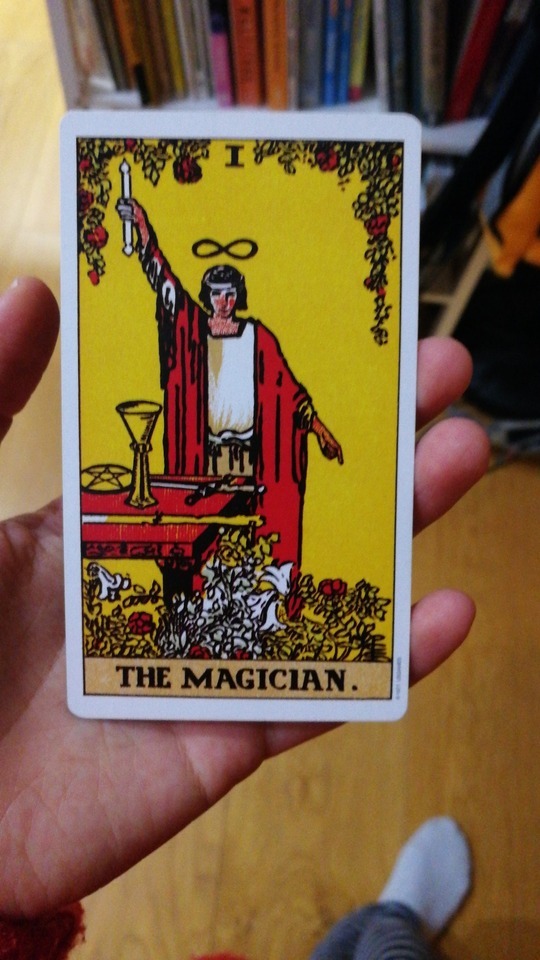
I did a task today with students working with the idea of only doing movements you've never done before. You start out trying to imagine a movement you've never done before, in full, and then you do it, pause, imagine another movement, do that one etc etc. Eventually you take the pausing away, so the imagining part gets blended with the doing part and you are just continuously doing movements you've never done before. I had them practice alone first and then watch each other.
A few of them complained that they were getting stuck and blocked up. They didn't know what to do. They couldn't think of any movements they'd never done before. Everytime they did the movement, it felt wrong. These responses feel typical of this kind of task, so here are some ways I would get past these issues. My response was, yes, of course you feel blocked. Probably because it's at once an impossible task and the easiest task in the world. I think it's helpful to separate out which part is impossible and which is easy:
It's impossible to imagine a movement in full and then execute it exactly as you imagined it. When you imagine a movement, there are necessarily many details you do not have the capacity to imagine or comprehend without physicalising it.
The part that's the easiest thing in the world is doing a movement you've never done before, because in a pretty significant way, every single movement you do, ever, is a movement you've never done before. Your body is constantly changing and shifting around, moment to moment, on a molecular level. The fluids move around, the skin grows, hairs fall out, things pass in and out of the bloodstream, constantly. If you repeat a movement, to some degree, you are a different person the second time around: it is never an exact repetition. So that bit is taken care of. Any movement you do is a movement you've never done before.
Where we need to come unstuck, then, is in dealing with the impossibility of imagining a movement in full and then executing it. My advice, and crucial to not letting a task like this overwhelm you, would be to fake it. In fact, I would argue that to do the task at all, you actually HAVE to fake it to some degree. To do the task, I have to enter into the FICTIONAL possibility that I could imagine a movement I've never done before and then execute it as I imagined it. You could even call it acting. I play the role of 'imagining a movement I've never done before and then doing it'. To the extent that it's impossible, it's fictional: play along with it.
Some other clarifications to help you unstick:
If you have an audience, it can feel like your audience is there to catch you out - to give you feedback. I would assert that your audience's ONLY job is to watch. If you still feel judged or inhibited (being watched can feel like this, even if it's irrational) remember that your audience is missing the relevant information with which to even attempt to judge you: your audience doesn't know what movements you've done before. Only you know!
This is not a task you can do badly or well, along some kind of sliding scale of merit: you are either entering into the fiction or you're not. In this fiction, there's no need to evaluate what you've done. It's a fiction, so we'd need to first invent the fictional criteria by which we are evaluating each movement. This might be something you get busy with, if you've got the headspace. But for now, try not evaluating, especially when things get faster, and you take the pauses away. Once you've done a movement, it's gone. Do it and forget about it, do it and forget about it, do it and forget about it.
2 notes
·
View notes
Text
Witchcraft as a choreographic practice

- Witchcraft as the practice of magic, whatever that means, by whoever and for whatever reason
- Witchcraft as the capacity to entertain several truths at once
- Witchcraft as holding things in relation
- Witchcraft as resisting the need to resolve, complete or integrate
- Witchcraft as the creation of, revelling in and tinkering around with contradictions
- Witchcraft as a dance of and with contradictions
- Witchcraft as tickling and being tickled by the bringing together of unlikely bedfellows
- Witchcraft as simultaneity
- Witchcraft as something else entirely
- Witchcraft as something else + something else + something else (entirely)
- Witchcraft as oscillation, flickering, glittering, shimmering, glitching, wobbling, faltering, faking, botching, matching, tinkering, corresponding, holding and smashing things together, with glee
- Witchcraft as the suspension of both absolute belief and absolute disbelief
- Witchcraft as wearing black, or whatever
- Witchcraft as creative duplicity
- Witchcraft as ‘that’ll do’
- Witchcraft as following instructions to the letter, or not
- Witchcraft as creating instructions to be followed, or not
- Witchcraft as the embrace of the makeshift
- Witchcraft as the intermittent, imperfect or incomplete transmission of signals
- Witchcraft as the active, specific, and temporary suspension of goal-oriented activity, in order for other kinds of activity to show themselves
- Witchcraft as the creation of conditions to access certain kinds of limitlessness
- Witchcraft as a choreographic practice
2 notes
·
View notes
Text
Channelling writing #3
Part 3 of a neverending practice.
From 28/04/18, residency at Yorkshire Dance with Es Morgan.
Writing for 10 minutes with the following in mind:
- Whatever you write already exists
- Everything you write matters
- Go with what you will
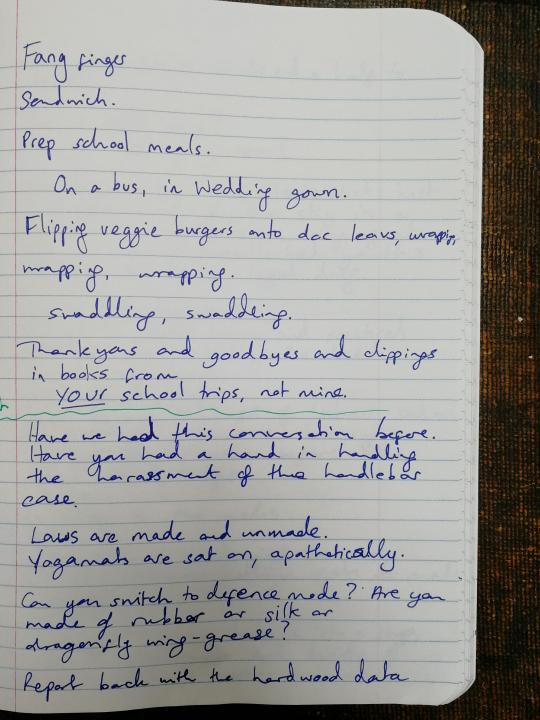
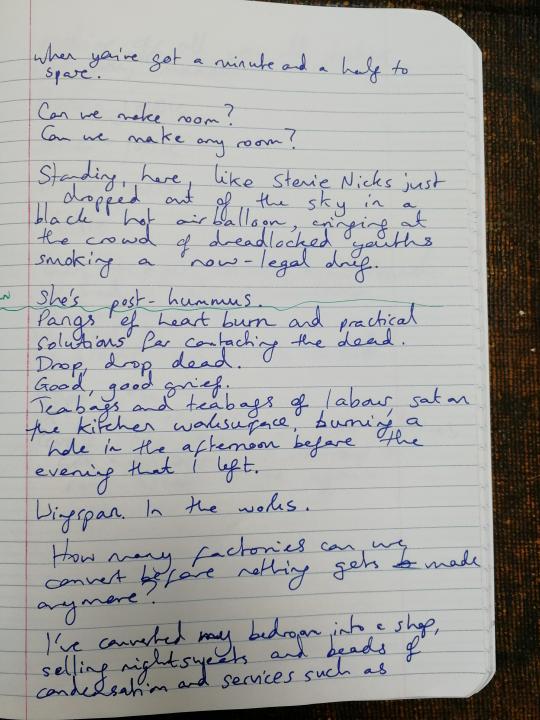
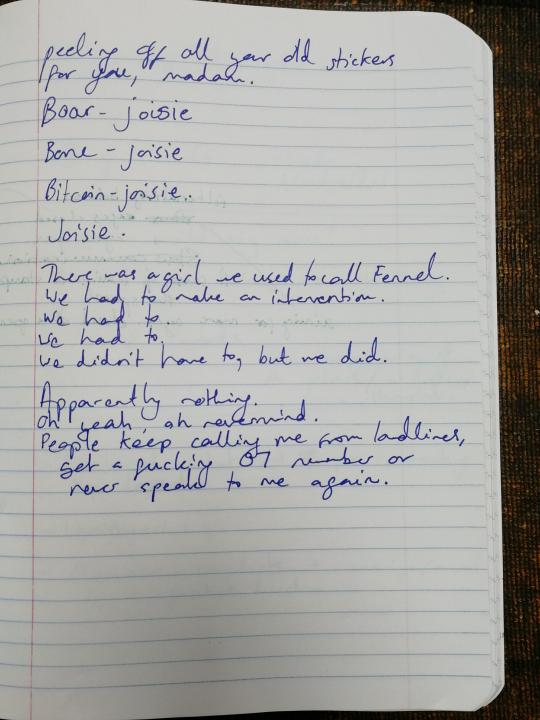
0 notes
Photo

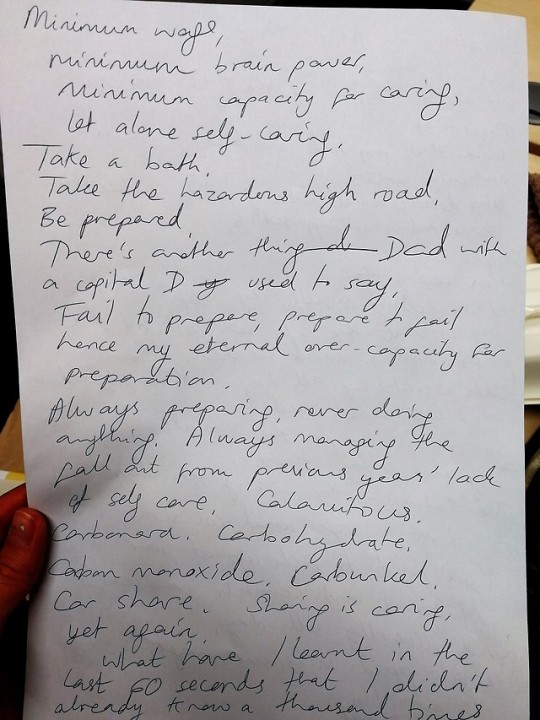
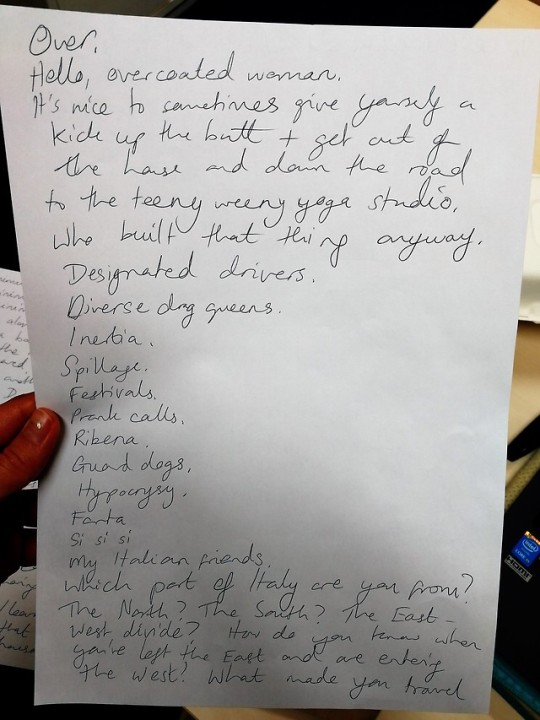

CHANNELLING WRITING #2
Written during a Choreography & Improvisation lesson I led at Roehampton University, 23rd January 2018.
The 3 principles of channelling writing are:
- Everything you write exists already
- Everything you write matters
- Go with what you will
1 note
·
View note
Text
Banishing Dance
“Dance-witch Charlie Ashwell wants to let go of stuff. She wants to ditch things; dump things; cast things off. An open-source ceremony to unearth and dislodge, Banishing Dance tunes into our capacity for visceral, affirmative solidarity, revealing the static buzz of changes waiting to happen; and the democratic power of magic to re-choreograph the future.”
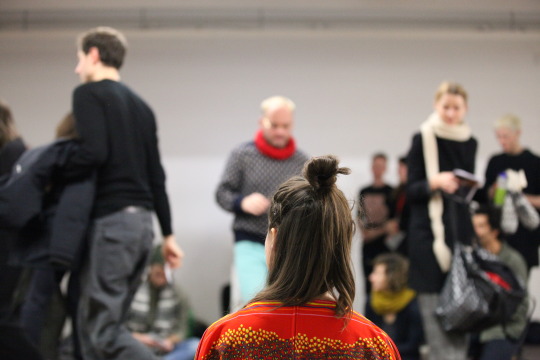

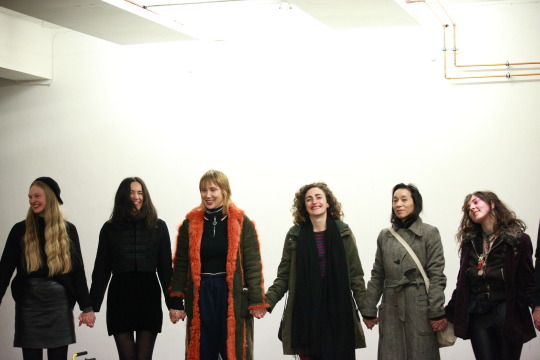
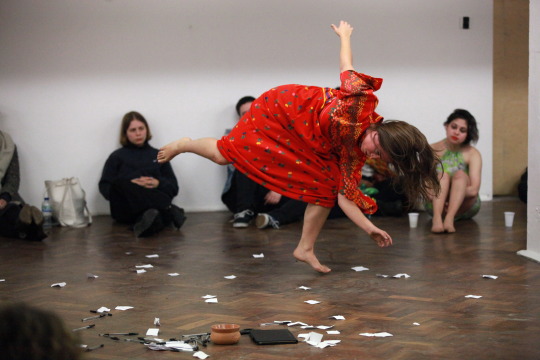
Banishing Dance has been performed at:
- GUSH (vol.1), curated by Jamila Johnson-Small on 17th April 2017
- ‘Future Ritual’ performance evening, curated by Joseph Morgan-Schofield & Thomas Yeomans, SPACE studios, Mare Street, Hackney on 15th Dec 2017.
Photos from ‘Future Ritual’ event, by Jemima Yong.
0 notes
Text
Channelling Writing #1

On the 24th November, I led a 3 hour workshop called WITCHDANCE at Chisenhale Dance Space as part of Openlab. This writing came from the task to write continuously for 10 minutes, with the following 3 principles in mind:
- Whatever you write already exists
- Everything you write matters
- Go with what you will
(Thanks to Antonio for posting his own traces of the workshop and prompting me to post mine.)
Here’s what I wrote:
Perhaps.
Flailing. Flute music fruitioning.
Ha lala la la
Like a song
from paradise park papers
Breaking ice open and paper mache-ing the crafty fox from Mile End Cyrus Cyprus tube station.
The woman driving the tube wears leather trousers. Her dinner still weighs a ton.
She’s pregnant.
Pause.
Lightyears away, a small frog, visible only to the ahuman eye nudges a gem of a rock, covered in moss, with his word wide webbed appendage.
Footnote: this is not frantic.
Nature has changed and we’ve democratically elected a square foot of moss as our leader. Bleed me dry later on the gorey details.
Do what you will.
Elect who you will.
Who do you actually will, though? Who even is that guy?
Right left right left, legible, left-leaning social democrat algae pills: you keep forgetting to take them and instead always go for...
Breathe. Green juice, green pond, green fingers, green bra, green bread. Just tear it off, it won’t kill you.
Things are piling piling piling opening opening opening doors and more doors
And no-one’s there.
Jelly contains beef.
Floor contains rubber.
Stomach contains bacteria, without which you, yes you, would not be here leading people towards fruity existences and those other words you never bothered to pick, no, look up.
Cram-berry.
Last minute hoo hoo hoo
People writing stuff without even spell-checking. Fingers go to Sunday school in Polly Pocket’s living room but only every other Sunday. The other Sunday they just sunbathe.
Getting rid of clutter. Open both windows and doors before you leave. Calamity. Jane or Joan or Juan.
0 notes
Text
On Availability
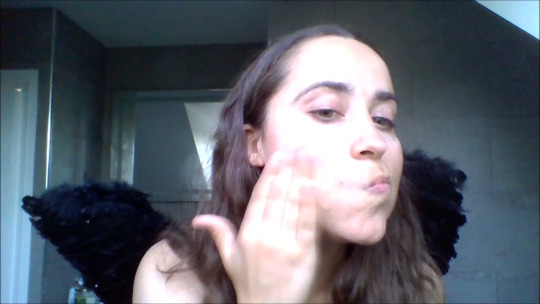
I’ve been thinking about availability.
The other day an email dropped into my inbox from the producer of a dance company. The title was ‘availability check’.
The producer was requesting my availability for a project.
Depending on whether I was available for the whole project, I would then be invited to an audition for that project.
Availability is contingent. That seems like an obvious thing to say.
My availability - i.e. the possibility of my giving up everything else to make myself completely available for that particular project, for that period of time depends on:
Other work I have going on
My desire to work with that choreographer on that particular project
The amount of money I currently have
other money I am likely to earn during that period (if I didn’t do the project)
How much the project is paid
WHETHER I EVEN GET SELECTED FOR THE JOB
Okay this is not just a moan about this manipulative audition culture.
Asking for my availability before I have any agency to make a fully-informed decision about whether to give my time to the work (time which includes the time of the audition… any time!) seems linked to a broader pattern of who is required to hand over their availability to forces beyond their control…
I think about domestic labour, for example.
My availability to work any given period of time is also contingent on my being able to reproduce myself as fit to work for that period of time. I.e. eat, sleep, shit, relax, take care of my body, take care of the bodies of those under my care.
And then I think about sexual availability and the double-bind that women are structurally, in neoliberal austerity capitalism, in a position where, to survive, they must be both intimately available... to care... to be soft and open and responsive and erotic... AND aloof/ independent/ resilient/ aspirational/ powerful. Wtf.
Then I think about precarious work. And how lack of structure means that those working freelance or zero-hours jobs have to work at the drop of a hat - for the money; because the future is unknown/ unstable. And how these jobs are often services. They talk about the ‘feminization’ of work. Service work. Work where you have to work to please, rather than simply work to get the job done.
When I used to work in a restaurant, for example, there were rewards for selling the highest number of steaks or whatever (gross - I’m vegan btw).
Yeah and sexual availability. I remember being told when I was younger that if I didn’t smile (and I didn’t smile that much - I was shy) then boys wouldn’t like me/ would be afraid of me/ would think I was frigid.
So what’s the relationship between the disproportionate extent to which “women’s work” or feminized work - or work which is somehow deregulated, which slips under the radar, which promises the absolute minimum in return/ remuneration, which is invisible, which is seen as menial, which disappears, which is immaterial - requires the subject to be in a mode of perpetual and limitless availability
&
the accumulation of profit under capitalism?
CLEANING WORK
CARE WORK
PRECARIOUS WORK
SEX WORK
EMOTIONAL LABOUR
THE WORK YOU HAVE TO DO TO EVEN GET WORK
And yes
Performance work
There is an intimate relationship between sex work and performance work.
So what do we do?
We do everything in our collective power make ourselves unavailable for the extraction of profit as an act of defiance. <3
- edited from text written on 23rd June 2017
0 notes
Text
Movements of care

I'm working as a mentor with Bristol-based dance artist Katherine Hall, for her new performance and writing research project about care. We spent the day together, talking and writing about care, how it is gendered, and how you might write a care 'score', or a set of instructions for enacting something between a performance and an act of care. We talked about how care labour is undervalued under capitalism, how, as artists, we might bring visibility to invisible acts of care and also how we might approach care as something creative, as a way of reinventing its place or value in work/ life/ art relations. Perhaps to open up questions around how it is done and who does it.
Here is something I wrote in 2 half hour sessions, in response to the task of describing movements of care.
Movements of care 1
The up and down/ round and round motion of brushing teeth
Which requires strength to hold my arm up
And I’m moving my lips out of the way, baring my teeth and craning my neck, tension in my jaw, face inches away from the mirror
I push the brush up into the very back and side of my upper teeth
And it feels strange because that area doesn’t normally get much sensation. And it makes me shiver.
The upward motion of splashing water onto my face, with a bit of an impulse; and soft fingers. I drag my fingers down my face, sometimes pressing them into my jaw and squashing my chin
Dragging a baby wipe down my armpit with the flat of my hand
Lying completely still on the floor, legs and arms outstretched in a V
Rocking across the back of my pelvis, my hands clasped onto my knees, directing, steering them side to side and round and round
The slightly firmer than usual stirring/ scraping motion you have to do to get the stuck food off the bottom of the pan when you've left it to cook a little bit longer than you intended and the solid bits have separated from the liquid and now you want to integrate it together so it's all the same consistency
The slow steady movement of raising the spoon to your lips to taste it
When you sink into a hot bath and suddenly your stomach muscles clench up in response to the heat and then they relax and your whole body relaxes with it and you take a deep breath, deeper than you've taken all week
Wringing the flannel to squeeze out the water to wipe the food off his face
The hand-eye co-ordination of twisting the knob on the washing machine to the right angle for mixed fabrics
Sliding the palm of your hand in circles on his back while he hyperventilates
Holding
The outward rotation of your arms in their shoulder sockets and the slight pull with your biceps that stops the shopping bags hyperextending your elbows
The twist of your fingers which turns the tin can in your other hand under the tap to clean the bean juice off it before it goes in the recycling bin
The way you control the size and speed of the expansion and contraction of your lungs to help you focus on something or to calm yourself down
The lean that you do to get something out of the sink to put it in the dishwasher when the dishwasher door is open and you don't want to close it just to get that one thing
Movements of care 2
When someone puts out their hand to stop you stepping out into the road in front of a car
When someone takes your plate after you've finished eating and then brings you a yoghurt and balances a spoon on top of the yoghurt because your hands are full
Picking up a wet sock, smoothing it out flat with both hands and then hanging it on the drying rack, at enough of a distance to the other pieces of wet clothing that it will dry properly
Picking up a wet sock that someone else just hung on the drying rack not smoothed out or too close to another piece of wet clothing and smoothing it out with both hands or putting it at enough of a distance to the other pieces of wet clothing so it will dry properly, but only when their back is turned, so it doesn't look like you are criticising their washing hanging and so you don't put them off hanging up washing in the future.
Walking up the stairs to the kitchen for the tenth time in the process of bringing the food to the table, to get everyone glasses of water one by one, as you realise nobody has water. And then doing the same for cutlery.
When they fold up your pyjamas and put them under your pillow
When you get into a fresh pair of pyjamas and then get into bed and realise not only had they made the bed but but they had also folded up your pyjamas from last night and put them under your pillow and you feel touched and also a bit guilty
When there are forks and knives on the table for dinner, but you are eating something like curry, which doesn't need cutting up, and the knives don't get used and then the knives get left on the table after everything else gets cleared away OR the knives get put into the dishwasher with everything else when actually they never got dirty and could have gone straight back into the drawer
When you are having a coughing fit and the person you're with thumps you on the back and it hurts more than it helps, but you say thank you anyway. And they always say 'are you okay?' and you always say 'I'm fine'
When you religiously water the plant in the bathroom every time you have a bath because it's next to you and you think it's probably a bit thirsty, like you, so you give it some water from your glass but you never water the plant in the living room because you never have that thought in the living room, so the plant in the living room dies
2 notes
·
View notes
Text
International Women's Day
Dependent women Interdependent women Queer women Hairy women Poor women Overwhelmed women Depressed women Women with chronic anxiety Women who can’t decide what to do with their lives Women who have never had the opportunity to decide what to do with their lives Women in their overdrafts Women over their overdrafts, being charged by their bank for it Awkward women Women doing care work, paid and unpaid Unemployed women Underemployed women Women who have given up on success, or whom success has given up on Women who refuse to let their value be measured by notions of success and failure
Women with regrets Women who feel ambiguous about shaving/ waxing their legs Women who want to go swimming or to the gym because it feels good to exercise but never go because going makes them feel too hairy and/or fat Alienated women Women who dissassociate Women who don’t menstruate Women who don’t have kids Women with postnatal depression Women who love women Women who love men they’re not supposed to Women who like cooking and cleaning but still sometimes feel alienated from the unpaid, unvalued nature of reproductive labour Women who take pleasure in wearing lipstick with moustache hair Women with chronic health problems Elderly women Women in the process of becoming women Women who have felt anger at both Hilary Clinton and Donald Trump Women in factories Women with 2 or more jobs Women on zero hour contracts Women who are antiwar but also critical of pacificism in contexts of imperialist white supremacist capitalist cis-hetero-patriarchal state sponsored violence Women who knit Women who can’t afford ethical clothing brands and also feel guilty about enjoying browsing Matalan for stuff they don’t really need Women in need Women who wish they’d chosen another career Homeless women Women who cannot leave abusive relationships because domestic violence services have been cut Women in prison Women who do sex work and face stigma for fighting for better working conditions/ just existing Women who need a holiday but can’t take one Women who want to take a break from everything, not only work Women who cheer themselves up by going to the 4th floor of John Lewis to look at desks and fantasise about having a room to write in, with a desk, in front of a window, with a cork board with all the things they’ve been wanting to write about pinned on it but they haven’t found the time or space recently even though they could be doing that right now but somehow being in the anonymity of a busy superstore is more relaxing
0 notes
Text
Indefinite list of needs
We need rooms We need floors We need spaces to breathe We need spaces to opt in without direction We need spaces to opt out and still be there We need spaces to find clarity and let go of clarity We need time We need excess reclaimed or redistributed We need windscreen wipers We need communication methods We need decentralisation of governance We need vocal chords We need others We need time and space to be present without use We need lunch breaks We need chargers We need roofs We need languages We need openness towards what might be or might have been We need much much more love We need
1 note
·
View note
Text
Basic Income, desire and dance training
I’m reading ‘The Problem with Work’ by Kathi Weeks. It’s great.
“As a provocation of desire - for more money, more time, more freedom - the demand for basic income, like the demand for wages for housework, sets itself apart from so many other approaches to political claims making. Rather than preach the ethics of thrift and savings, the politics of concession, or the economics of sacrifice, the demand for basic income invites the expansion of our needs and desires.” (p. 146)
As an artist and producer working in (and on/ with the margins of) dance, I am thinking a lot about how we maintain our work and lives as dance artists and how this is political. For me, forms of training - classes that we go to and that we teach - not only reproduce or react to the artistic work we do, but also create the work itself. I’m interested in the economies of movement proposed by different forms of dance training and choreography and how these are immanent to the economic situations of dance artists and the politics attached to our work and lifestyles.
It seems to me, in line with the demand for a universal basic income put forward by Kathi Weeks, that a really important political project for dance now would be to create/ demand contexts - time and space - in which we, as artists and politicised subjects are able to expand our needs and desires. We have a long history of occupying and upholding work and study-places where our desiring bodies are tightly honed into producing particular aesthetics for particular types of choreography. That time is coming to an end. Modes of working in and with dance are becoming more collaborative, communicative and affective, in line with broader shifts towards post-Fordist forms of labour under neoliberal capitalism. (As Michael Hardt and Antonio Negri argue, these shifts also hold the key to resisting capital’s grip on all forms of life.)
Training contexts and methods which create time and space in which to expand our needs and desires would go beyond what I see as the two prevalent approaches to dance training at the moment, which respond to, but are limited by the instrumentalizing forces of neoliberalism:
- a kind of ‘magpie’ approach - where the onus is on the individual dance artist to train in as many different forms as possible, accepting or negotiating the risk of burnout and maximising/ diversifying skill in order to be as employable as possible across the dance ‘industry’.
- a kind of ‘thrift’ approach to movement - dance techniques which advocate doing less movement - or doing all movement more efficiently - for the preservation of energy and minimisation of risk in order to make dancing more sustainable in the long run.
A radical approach to the future of dance would not be about rejecting or throwing out entire techniques or manifestos. In that a dance class is something that we do together, any instance of this coming together already holds the potential to create a new politics of dancing. We need to add to that, however, the question of how dance training might refuse to accept neoliberal capitalist conditions/ limitations and thereby transform them. Dance training is not just about individual preference, canny business strategy, survival technique, self-improvement or most-relevant skill acquisition. Training is always also collective, creative, political and choreographic. And we must make it so.
As dance artists, we both produce and reproduce the contexts in which we work. Exactly who has the knowledge and authority (as well as incentive, perhaps!) to teach and what form that knowledge takes is becoming dismantled and put together in new ways. Now, potentially: everyone a teacher, everyone a student. In light of this unavoidable merging and expansion of teaching and studying, training and choreography, work and life, what kind of dancing do we want to do together?
Here is a video of Cyril Baldy and Tilman O'Donnell, who “have no answers”, talking about their work on ‘Whateverness’.
“What we’re doing is not a protest. It doesn’t go against anyone or anything. Actually, on the contrary, I think it takes all of this and looks at it and tries to create another situation, incorporating what’s there already and maybe what’s not there and see what emerges.”
youtube
5 notes
·
View notes
Text
Interview with Simonetta Alessandri for TripHazard

I have been working as co-producer at TripSpace on the project TripHazard: New tendencies in training and choreography. TripHazard provides a framework in which dance practices might travel between and across contexts of morning class and rehearsal room; where relations between training and choreography can be defined, discarded, articulated, re-articulated and danced all over. As part of the project, I have been interviewing the participating artists.
Here I chat to Simonetta Alessandri about her research.
Hello, hello!
Hello, hello.
What are you doing for TripHazard?
I will work with Feldenkrais as an access to researching movement. This is my recent interest in the last few years. And then, my work will be researching Tarantism.
Tarantism?
Tarantism is a dance and music tradition from Italy. It’s kind of a trance form, specific to the region of Puglia.
Is it practised by everybody from this region? Or is it a kind of performance?
There are two different aspects. In the more recent one it’s become a little bit touristic, so they reorganise it in an accessible way for people to learn. It’s transformed into a kind of folk dance; a dance where the men want to catch the women. There’s improvised words and music and it’s very very frenetic and a very very fast beat.
But originally, tarantism was more like a phenomenon or trance dance movement practised in the south of Italy in general but especially in Puglia. There were a few appointments during the year where women, like ninety-five percent women, were able to express themselves in a very aggressive way. You never heard about that?
I’ve heard about a phenomenon where big groups, big communities, have this kind of dancing disease where they can’t stop dancing. But maybe that’s something totally different.
I think tarantism is not the only one, for sure. There are some very interesting documents, videos, from the late 50s of these women meeting together in a church and just getting crazy for like 2 days. They were really in that physical state where they could have done anything… to express themselves. And the musicians were helping them to get more and more out of this. It’s not anymore so real. But I think until the 70s, it was real.
So is there something kind of functional about it?
Of course.
About letting go of something which has been held for a long time?
Absolutely. They were in rural 40s, 50s and either unable to cope with their society, or really sick. They were in a very specific land between mental illness or just incompatibility with society.
I mean, sick society, right?
Yeah. And so this was a way to really express themselves.
Do you have in mind some connection with this and your current practice of Feldenkrais into performance?
I think it’s always a little bit unknown. I’m interested to research into this land of trance. This ‘do the ritual’. ‘Be in the rituality’. So there is something about the authenticity of being really there because it’s what you really want to do; it’s the ritual that will help you and also you will get totally lost in this. So there are some aspects that are already close.
Feldenkrais strikes me as a very mindful practice. And also very practical. And then on the other hand, when I think of trance, I think of compulsion… movement that you can’t help but do.
There are similarities in the work. Feldenkrais is very practical and functional, as you said. But there’s also a mind state that you can go into that is this slow pace; that could potentially go more into the practice of Milton Erickson, for instance, one of the first important hypnotists. He was a friend of Feldenkrais, so they studied and explored together. And actually, when you do Feldenkrais, you really arrive in a mind state that is different. The heartbeat slows down, sometimes people start to sleep and you go in between.
Semi-conscious, almost?
Semi-conscious, yeah. Sometimes you could fall asleep and then have a sense that you actually understood the class because the words the teacher says arrive anyways, no? You see something.
You begin to dream.
Yeah. Kind of like a dream. But, as you said, the idea is to be able, afterwards, to reconnect to your body, to understand and to use it in normal life, also. As a human being.
Can you say a bit more about what Feldenkrais is?
It’s a somatic method. So you learn from inside. But it’s also a self-directing method. You learn, basically, how you learn. And the movement is the place where that happens.
There is a lot of space because you don’t follow, you don’t see an action; the request is vocalised. So you’re not copying anyone - you are thinking about the action and you are exploring. It’s very, very explorative. And it makes you aware of a different zone - that are not your habits - so you can start to question where your habits are and then how to get rid of that.
To what’s kind of pre-habit, or…
Yeah, we are full of habits; physical and mental habits. And some are very important but we need to recognise that we need to be able to make choices. So, it’s a method about awareness through movement. And the awareness could increase, increase, increase and become more and more and more sophisticated.
You are understanding what is working for you and what is not working from the sensation. It’s very different than always referring back to somebody else telling you if it’s correct or not.
That seems quite linked, to me, to this question of the dancer as artist; as maker within the structure of the choreography that they’re working in. That as a dancer you’re constantly assessing and reassessing your interests in relation to the choreography.
Exactly. This is a really important starting point. You are self-directing. You are understanding from the inside. And then there’s a different sense of collaboration.
youtube
0 notes
Text
An interview with me by The Rebel Man Standard
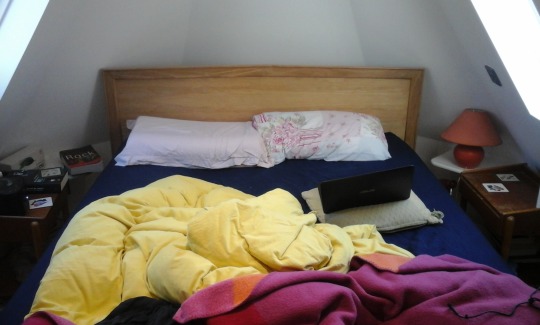
“I’m plagued by the question of how we make ourselves visible in a climate where the visible places can be very cruel; very dismissive of some bodies: unruly bodies, perhaps; dissenting bodies; not-so-able bodies.”
http://therebelmanstandardinterviews.tumblr.com/post/136697940407/charlie-ashwell-what-do-you-consider-to-be-the
0 notes
Text
Interview with Seke Chimutengwende for TripHazard
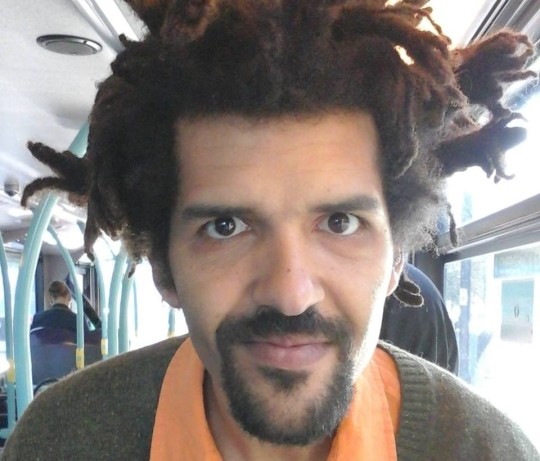
I have been working as co-producer at TripSpace on the project TripHazard: New tendencies in training and choreography. TripHazard provides a framework in which dance practices might travel between and across contexts of morning class and rehearsal room; where relations between training and choreography can be defined, discarded, articulated, re-articulated and danced all over. As part of the project, I have been interviewing the participating artists.
Here I chat to Seke Chimutengwende about his three research weeks, ‘Mass’, ‘Material’ and ‘Disturbance’.
Hello!
Hi.
What are you interested in at the moment, in or out of dance?
Well I’ve been listening to a lot of P-Funk, as you know. George Clinton.
What’s P-Funk?
George Clinton is a singer, songwriter and producer and he was involved with several bands in the 70s and 80s: Parliament, Funkadelic, Bootsy’s Rubber Band, Brides of Funkenstein etc. P-Funk is the music they created. So that’s one thing.
This is a hard question.
I’m interested in veganism, I’m interested in socialism, I’m interested in Afrofuturism, politics... and I’m still interested in improvising.
Your three weeks of research have got three different titles: ‘Mass’, ‘Material’ and ‘Disturbance’. Do they relate to anything you just said?
Haha, yes.
And how do they relate to dance?
Yeah, they very much relate to what I just said. I’m interested in people coming together and working together. That’s what I like about making performance, that it’s a group effort. Even when I do a solo improv, I feel like it’s a group effort with the audience. It’s always for people who are there at that moment. And politics is like how do you work together with other people? To me that’s what politics is. How do you create systems, how do you negotiate, how do you respond to people? And that’s obviously a constantly ongoing, changing process.
I’m also interested in the fact that lots and lots of people are going vegan at the moment. It feels like a mass movement. I’m really interested in what happened with Jeremy Corbyn and also the SNP. Suddenly lots of people doing something. Or, you know, we went on the refugee march the other day. So I’m interested in these movements of people; mass movements in order to try and change something about how we live together. That’s the kind of logic of why I make work and why I teach.
So 'Mass' is like how do we work together? And 'Material' is like what is the stuff that we’re working with?
It feels like there’s an inherent contradiction, in a way, between dance and the idea of material because movement is immaterial.
Yes. Well there’s two sides of that that come to mind. There’s the material of the body and whatever else is in the space. And then there’s the material of memory, which is a huge thing to deal with in performance and making work. I’m working with my body and I’m working with memory, those are the two materials. And they’re not separate either, they’re very linked. When I’m improvising, I’m basically putting loads and loads of memories together in a certain way, on the spot. And when I’m choreographing I’m also remembering how I put those memories together and repeating it, over and over again. So that’s material.
And ‘Disturbance’... ah… I guess, following on from everything else I’ve been saying, I feel disturbed by a lot of things that are going on in the world. And I feel like I also want to disturb existing ways of thinking, existing orders that I think don’t function well. It’s funny that they’re in that order. It’s quite artificial, somehow, but there’s something about people coming together and making something and what does that thing do? What’s it for? What does it respond to?
My mind is stuck on this material thing. I’ve been reading a book by Bojana Kunst called ‘Artist At Work’ and she talks about the likeness between performance, particularly contemporary dance, and new forms of labour, work, under capitalism, which is about it being immaterial. And so maybe focussing on materiality, on the material of the body and the material of performance, is a kind of challenge to that. Yeah, I just wanted to add that.
So, TripHazard was created as a place to reassess the relationship between teaching practice and choreographic practice. What kind of relationship do they currently have for you and are there any other potential relationships that they might have in TripHazard?
The way I teach and the way I make work, or have made work so far, are very linked in that I set up structures for people to improvise in.
Right.
That’s what I do when I teach and that’s what I do when I make pieces. And there are ideas in the pieces that have come from stuff that I’ve been working on in my teaching and there’s ideas that I teach that have come out of choreographic processes. So there’s quite a porous… is that the word?
There’s a revolving door…
Yeah, it’s symbiotic. When I teach I start with some things that are quite specific and then I try and open it out, more and more. And when I choreograph, I start with the same kind of things as when I teach and try and make them more and more specific. When I teach, because I teach improvisation, I’m kind of teaching away from scores, or trying to open up the scores; remove elements of them.
Beyond scores.
That’s the goal.
Okay. One last quick question. What are you looking forward to about TripHazard?
I love not knowing what’s going to happen. That’s the thrill of going into a studio or performing improvisation, that I don’t know what’s going to happen. That’s so exciting. I’m also really looking forward to working with people that I've worked with a lot before, as well as some new people. And having five days in a row where I do more or less the same thing everyday!
Haha. Great.
www.sekechimutengwende.com
2 notes
·
View notes
Text
Sara Ahmed on the danger of defining freedom in terms of movement
I’ve been thinking about how improvisation and choreography relate in dance practices. I would like to challenge the tendency to conflate improvisation with freedom and choreography with restriction, through writing about performance processes in a way which reveals how they work with both freedom and restriction at once. What kind of freedoms can dancing make and unmake? What kind of language would articulate the potentials and limitations of these complex attempts?
Here are some words about queerness and freedom which feel generative for these questions. They are from Sara Ahmed in The Cultural Politics of Emotion, p. 151-2, in a chapter called ‘Queer Feelings’.
“[T]he positing of an ideal of being free from scripts that define what counts as a legitimate life seems to presume a negative model of freedom; defined here as freedom from norms. Such a negative model of freedom idealises movement and detachment, constructing a mobile form of subjectivity that could escape from the norms that constrain what it is that bodies can do [...] The idealisation of movement, or transformation of movement into a fetish, depends upon the exclusion of others who are already positioned as not free in the same way. Bodies that can move with more ease may also more easily shape and be shaped by the sign ‘queer’. It is for this reason that Biddy Martin suggests that we need to ‘stop defining queerness as mobile and fluid in relation to what then gets construed as stagnant and ensnaring’ (Martin 1996: 46). Indeed, the idealisation of movement depends upon a prior model of what counts as a queer life, which may exclude others, those who have attachments that are not readable as queer, or indeed those who may lack the (cultural as well as economic) capital to support the ‘risk’ of maintaining anti-normativity as a permanent orientation.”
This last bit makes me think of the demand of neoliberalism to constantly innovate, adapt and change. Where do dance and other performance practices sit in relation to these demands? What kind of freedoms do we need to make now?
1 note
·
View note
Text
Interview with Rick Nodine for TripHazard
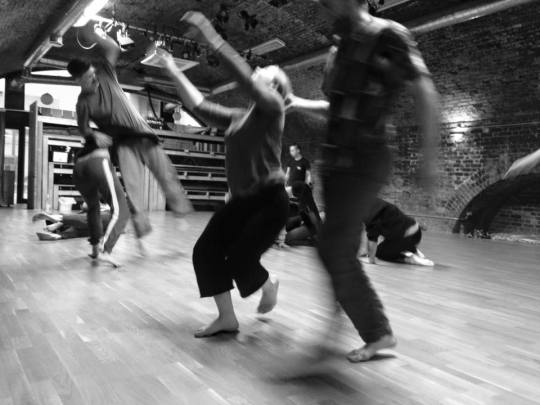
I have been working as co-producer at TripSpace on the project TripHazard: New tendencies in training and choreography. TripHazard provides a framework in which dance practices might travel between and across contexts of morning class and rehearsal room; where relations between training and choreography can be defined, discarded, articulated, re-articulated and danced all over. As part of the project, I have been interviewing the participating artists.
Here I chat to Rick Nodine about forms of training, the politics of Contact Improvisation and the magic of warming up.
Welcome to TripHazard.
Thanks.
What will be happening in your TripHazard classes?
I suppose the same thing will be happening in my classes that has been happening in my classes in the last year. A bit of a return to Contact Improvisation. I spent a few years trying to teach a different sort of class when I taught a morning professional class. And that was interesting and challenging, but at a certain point I felt people weren’t really getting the best from me.
Haha. And the best from you is…
I’m a good Contact teacher. And if I teach in the context of thinking about it as a Contact class, I can do things that branch off from Contact Improvisation.
Is there something different about teaching Contact as a morning class than it is as teaching it in other ways, such as moving into a jam? Or...
Teaching in the evening, open class.
Yeah, evening classes, or maybe in the context of a school it can become more like a “complementary” training?
For me I don’t mind whether they’re thinking about it as complementary or not. In the moment of doing the class, it’s their morning class. And people mix up what they do for morning class all the time - everything these days is complementary to everything else.
The days are gone where your standard class, if you want to be in a contemporary company, is Graham. In this country it was like that for years. Graham was the class and then it became Cunningham and now - here, anyway, at London Contemporary [Dance School], it could be anything. I love teaching Contact in the morning because people are brighter, more energised. I’m brighter, more energised.
I have this feeling as a freelance dancer at the moment that everything is extra. And so there’s this danger of ‘why do anything?’
Yeah. Like ‘why do any particular form?’ Am I reading it rightly? Or ‘why do class at all?’
Yeah, I guess ‘why do class at all?’ and if I do do class, I’m more open to just go with what’s being proposed. No matter what it’s called.
Yeah. Although I recognise after years and years of dancing that I feel better on days that I dance.
Oh god, yeah.
And I feel better on days when I do particular sorts of dance. I can enjoy going to a ballet class but it’s not the most efficient way to get to my energy. To get my energy moving.
Because it’s not my home form. And it makes me think I should just admit something about the form [of Contact Improvisation]. I started dancing late and I started dancing Contact Improvisation so it’s my folk dance. You can see limitations of it, you can see advantages of it, but the truth of the matter is - it’s just who I am.
So, today the government is voting on whether to bomb Syria.
Yeah. Shame they even have to have this vote.
And I’ve read and seen people talk about Contact Improvisation as having emerged alongside a very clear anti-war activism.
Yeah. Yeah.
And I’m wondering does Contact still have any kind of activist potential?
I think only in the personal sense. And there are people who extrapolate or expand what they do physically into being very busy on a political scale.
But I do believe that Contact Improvisation creates a psychological and social environment where people have a chance to be a little bit happier than in some dance environments that promote a bit more competition and a bit less co-operation. And I don’t know how huge that difference is but it’s enough to make it important for me to teach that rather than something that pushes people to compare themselves to one another in a negative way.
What’s your vision or utopia for dance?
At this point the recording cut out! It started again here:
I feel like there’s a movement towards academicism happening in dance and it’s pushing me into a slightly reactionary position of going ‘yeah but dance is about the body’ and actually I don’t even feel that way. I love discussing things and thinking about things. But there’s a kind of academicism which is bullying people in the same way that ballet bullies people with particular sorts of body types and virtuosities. There are kind of mind-types that are able to flex their intellectual muscles in particular ways which is not always very welcoming.
And I think because I work in an educational institution, there’s this big thing about dyslexia and dyspraxia and about types of learners and communicators and engagers. I’m dyslexic and I grew up in a period where that was called ‘stupid’. And I have a lot of shame around my ability to read quickly or type or spell. And my inability to engage with an administrative style of life. And that goes hand in hand with showing yourself in the current world of what is considered ‘contemporary’ in terms of your knowledge of particular forms of discourse.
That you have to say that your work is either very dancerly or very intellectual and that those two cannot be together?
Yeah. And this is very personal. It feels like those ‘camps’ - this is classical and this is modern and this is contemporary - in some ways it’s still being propagated. You know, these are the clever ones and these are the ones who are still naively obsessed with the body.
And I find it almost patriarchal. If I think about the number of men who are “allowed into” dance without having done any dance classes, because they’re smart and have read a lot of philosophy. And then I try and think of a woman who’s not done a really hard core training and been a really good dancer and is also recognised for her mind - they actually don’t exist.
Men are allowed to be smart and women still have to dance really well and if they’re smart, that’s a ‘bonus’. All you have to do is look around and count.
It’s like this question ‘Where are the women?’ Like, what the fuck? We’re surrounded by them! Where are you going and finding no women there?
Yeah. So something about that new strand coming off as quite conservative, sometimes, to me.
I definitely think there’s a gap. I think there’s a gap after or beyond ‘somatic practices’ - which is a really broad term - where it went really ‘non-dance’ and now we’re a bit in this appropriation phase, where we want to take dance from everywhere, but the potential of those somatic practices has been discarded, somehow.
And everything’s a reference so that old romantic ideal of the individual artist coming up with a vocabulary of their own - actually doing some movement research.
Yeah, haha. What happened to movement research?
It’s uncool, somehow. Which feels very odd to me as someone who still likes to warm up everyday; still gets a very visceral, physical pleasure out of that process and even if I find a tiny little variation on a pattern that I did yesterday, I’m pleased.
Maybe you could say a little bit about what you’re researching in TripHazard.
I think I’m going to spend a week trying to find ways of shining a light on some people warming up. And I think I’m going to do that through light and voice. I’ve got an idea of a bunch of microphones hanging from the ceiling, so if your head’s resting on the floor, the microphone is quite close to your mouth. And then lots of things that people do in contemporary dance when they first lay down. Shake and roll their head. And we’ll look at people going through a process, over quite a long period of time. And it leads to more vigorous dancing but they’re real physical states.
There’s something still a bit magic about when you come off the street and you go in the studio and you lay down and actually you turn into someone else through this magic ritual of shaking and letting gravity spread you out.
It’s almost chemical or something.
It’s chemical and also mechanical. Parts of you actually release and soften and open up. I’m very much thinking about it being a durational installation. It’s for the middle of a room. So people would sit around. I’m very clear that I don’t want an audience to walk in and think ‘this is the beginning’ and ‘this is the end’. So yeah. Lights and sound and something very physical that’s not very vigorous.
Nice. Can I stop it?
Sure.
(Image of morning class with Rick, by Cristina Pérez Sosa)
0 notes